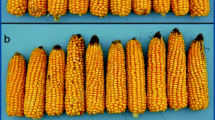Abstract
Corn cob fusariosis symptoms were observed at four localities of Poland: Radzikow /Central region/, Kobierzyce /South West/, Swadzim /Central West/ and Smolice /Central South/, during the 1985 and 1986 growing season. SpeciesF. subglatinans was found as dominating, causing in about 95% of affected cobs symptoms of “pink ear rot”. The other important species ofFusarium which infected corn cobs wereF. culmorum, F. graminearum, F. sporotrichioides, F. avenaceum, F. moni1i forme. A first time in Poland was found the speciesF. crookhiellense. The intensity of particular genotypes fusariosis was expressed as fusariosis index /Fi/ ranging from 0 to 500. Susceptibility to Fusarium ear rot differed significantly between examined corn hybrids and varieties from 0 to 245 Fi, it let to eliminate hybrids very susceptible toFusaria infection of cob.
Similar content being viewed by others
References
Chelkowski J, Zajkowski P, Zawadzki M, Perkowski J Moniliformin, Deoxynivalenol, 3Acetyldeoxynivalenol and zearalenone — mycotoxins associated with corn cob fusariosis in Poland. Mycotoxin Research, p 25
“Compendium of Corn Diseases” (1973). American Phytopatological Society Inc., St. Paul, Minesota USA
Czaplinska S, Jasa S (1980). Studies on maize resistance to Fusariose: I. Evaluation of Maize resistance to Stalk rot and Ear rot under conditions of natural infection. Hodowla roslin, Aklimatyzacja i Nasiennictwo Vol 24: z.3, 258–266
Marasas WFO, Kriek NPJ, Wiggins VM, Steyn PS, Towers DK, Hostie TJ (1979). Incidence, Geografic Distridution and Toxigenicity of Fusarium Species in South African Corn. Phytopathology 69 p. 1181–1185.
Mesterhazy A (1982). Resistance of Corn to Fusarium Ear Rot and it’s relation to Seedling resistance. Phytopahology 103 p. 218–231.
Neish GA, Farnworth ER, Greenhalgh R and Young SB (1983) Observations on the occurrence of Fusarium species and their toxins in corn in Estern Ontario. Can J Plant Path 5, 11–16.
Nelson PE, Toussoun TA, Marasas WFO (1983). Fusarium species. An Illustrated Manual for identification. The Pennsylvania State University Press, University Park and London
Nirenberg HI (1981). A simplified method for identifying Fusarium spp. occuring on wheat. Can. Jour. of Botany 59: 1599–1609
Sutton JC (1982). Epidemiology of wheat head bligth and maize ear rot caused by Fusarium graminearum. Can. Jour. of Plant Pathol. 4: 195–209.
Schuh M, Glawischnig E, Leibetseder J (1982). Natural occurrence of mycotoxicoses in Austria associated with mycotoxin-contamination feedstuff. Proseedings V Int IUPAC Symp “Mycotoxins and Phytoxins”. Techchnical University Viena, p. 118–121.
Author information
Authors and Affiliations
Rights and permissions
About this article
Cite this article
Zajkowski, P., Kwasna, H. Corn cob fusariosis — Natural infection of various genotypes in 1985 and 1986. Mycotox Res 3 (Suppl 1), 95–98 (1987). https://doi.org/10.1007/BF03192038
Issue Date:
DOI: https://doi.org/10.1007/BF03192038




